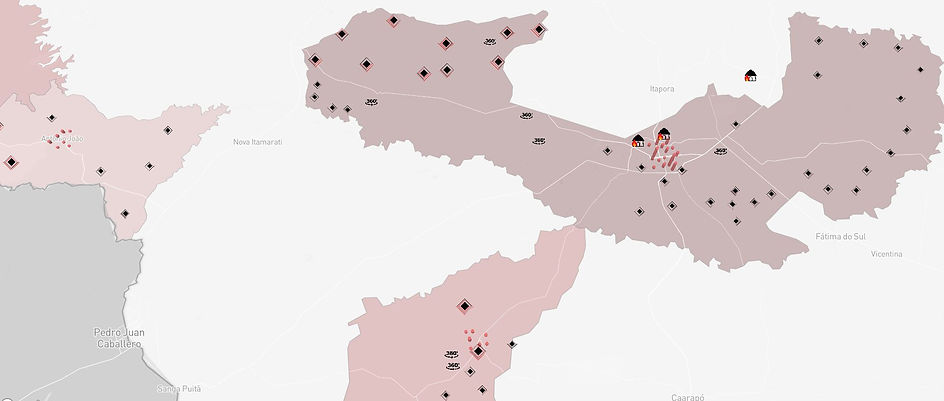
Making Violence Visible
Mapping Violence Against Guarani and Kaiowá women
Context
Mato Grosso do Sul (MS) has been identified by the Forum Brasileiro de Seguranca Publica as one of the states presenting the highest incidence of violence against women in Brazil. Recent UN reports highlight that women from the local Indigenous community, the Guarani and Kaiowá, are particularly at risk of suffering sexual and gender-based violence.
In the face of negligent government responses and increasing cases of violence against women brought by the Covid-19 pandemic, Guarani and Kaiowá women have been developing their own strategies to combat this endemic issue. Since 2006, the Kunangue Aty Guasu (KAG), the Guarani & Kaiowá Women’s Council, has been organising yearly assemblies where women representatives of various communities share their experiences to develop collective strategies and political mobilisation to this endemic issue.
Making Violence Visible builds on a voluntary collaboration between the Kunangue Aty Guasu, the Institute for the Development of Art and Culture (under the presidency of Fabiana Assis Fernandes), Raffaella Fryer-Moreira and the UCL Multimedia Anthropology Lab. Since 2021, the partnership has been exploring how to support local women as they turn this violência silenciosa (silent violence) into a narrative.
MAPPING VIOLENCE AGAINST INDIGENOUS WOMEN: PILOT DIGITAL MAP (2021)
DIGITAL NETWORKS OF RESISTANCE (2022)
SUPPORTED BY THE UCL GLOBAL ENGAGEMENT FUND
RAFFAELLA FRYER-MOREIRA
FABIANA ASSIS FERNANDES
JAQUELINE ARANDUHÁ
CAMILLA ROSSI
JEROME LEWIS
LUIZA BRAGA

Origins of the Project
The data represented in the map have been collected locally by the Kunangue Aty Guasu and IDAC between 2017 and 2020. Their findings were summarised in the report ‘Corpos Silenciados, Vozes presentes: a Violência no Olhar das Mulheres Kaiowá e Guarani’.
‘Making Violence Visible’ developed as a radically collaborative and decolonial exploration of community-led participatory research. In a context where cultural and infrastructural challenges have historically excluded Indigenous communities from participating in scientific research and from accessing justice, the development of the map aimed to support the KAG's capacity to identify, collect, and disseminate new datasets on their own terms. The map was designed through in-depth conversations with the community so to accurately represent what violence means for Guarani and Kaiowa women.
The project was developed at the request of the Kunangue Aty Guasu to create an interactive digital map showing the incidence and geographical distribution of violence against Guarani and Kaiowá women in Mato Grosso do Sul.
Jaqueline Arandhuá, Indigenous Anthropologist and current KAG coordinator, explains the need to address digital invisibility among Indigenous communities.
Project Outputs

Local Categories of Violence
As often emphasised by the KAG, there is no translation of the word "violence" in Guarani, their traditional language. To open up space for local understandings of violence to emerge, the project started with an in-depth collaborative analysis of the KAG's report, which was translated to English by the UCL MAL Translation Team.. These first discussions led to identifying context-specific categories of gendered violence, such as moral violence, religious intolerance as well as arson, disease, and pesticide. These categories were then used by the UCL MAL team to identify and analyse cases and incidents of violence emerging in the report.
The KAG highlighted that these categories of violence often take place at the same time, manifesting in both physical and psychological harm. They also often emphasise that any kind of violence against Indigenous women needs to be understood in relation to the local history of colonial violence and environmental exploitation.
Decolonising Mapmaking
Building from these discussions, the UCL MAL team began experimenting with different GIS software to understand how to best represent the intersectional and multi-sited nature of this violence, while also reflecting Indigenous aesthetics and traditions, from the colour of the territories to the symbols of the pop-ups.


All reports of violence were recorded in both English and Portuguese to make the map more accessible and to reflect Guarani and Kaiowa’s oral tradition. Each report was recorded by a different woman, bringing into the map a variety of voices, accents, and backgrounds. This collection of voices aims to reflect how Guarani and Kaiowá’s stories have been amplified nationally and internationally through an increasingly growing network of support. The recordings were then integrated into the map and accompanied by images or videos of the Guarani and Kaiowa territory, grounding the narrations into context.
Building an Indigenous Digital Identity
While the map was developed, the partnership also worked on creating a website for the KAG to upload their reports and amplify their fight. The website was designed in tight collaboration with Guarani and Kaiowa’s nahanesy (shamans), and integrates colours and graphismos traditional to Guarani and Kaiowa’s culture


